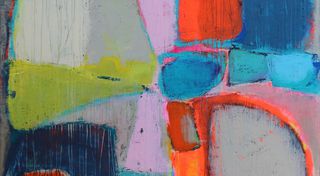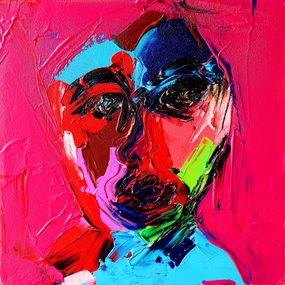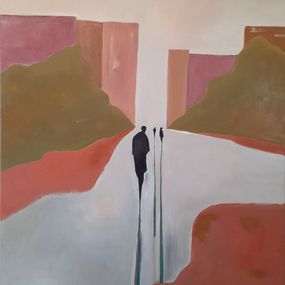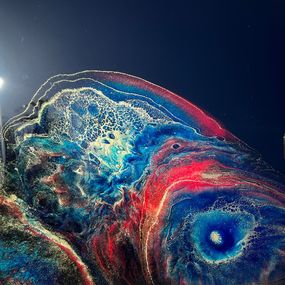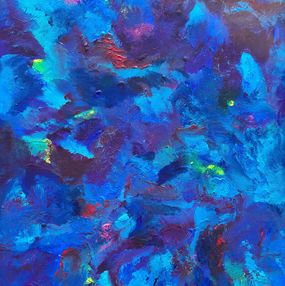
Untitled (man of color series),
2022
Harold Smith
Painting : acrylic
61 x 45.7 x 0.5 cm 24 x 18 x 0.2 inch
Free returns within 14 days
Authenticity guaranteed
Learn moreSecure payment
About the artwork
Type
Unique work
Signature
Hand-signed by artist
Authenticity
Sold with certificate of Authenticity from the gallery
Invoice from the gallery
Dimensions cm • inch
61 x 45.7 x 0.5 cm 24 x 18 x 0.2 inch Height x Width x Depth
Framing
Not framed
Artwork sold in perfect condition
Artwork location: United States
About the seller
Zatista Contemporary & Fine Art • United States
Artsper seller since 2022
Vetted Seller
This seller rewards your purchases of multiple artworks
Collector’s Guide
Imagine it at home

Discover more by the artist
Presentation
Harold Smith: Art As a Platform for Activism
by Alice Thorson
May 1, 2017
Articles , Cinematic , Literary , Visual
The KC painter, filmmaker, editor and writer celebrates the contributions of black culture and pushes against racism.
If a person wants to know what happened, read a history book. If they want to know how it affected people, look at the artwork. This adds to the importance of black art throughout history. It is like hieroglyphics. —Harold Smith
On a warm evening in late February, the premiere screening of “The Gospel According to Glenn North" played to a packed meeting room at the Kemper Museum of Contemporary Art.
Many in the audience had come to honor North, the nationally renowned inaugural poet laureate of the 18th & Vine Historic Jazz District, but they left the event with a new appreciation for the talents of the documentary's creator, artist Harold Smith.
To date, Smith is best known as a painter — of dynamic expressionist canvases fired by his love of jazz and jazz artists. “When I connect with jazz, I feel a sense of freedom," he has said. Smith credits jazz with keeping the spirit of African Americans alive during decades of segregation and racism.
In 2011 Smith rocked the American Jazz Museum with his exhibit “Colors of Jazz," featuring six dozen of his vibrant canvases, several of them threaded with political commentary in the form of news clippings collaged amid the bright slashes of paint. The exhibit included poems by North that expanded on the ideas in the artworks.
The North documentary is Smith's fifth film; he is also a poet, the founder and editor of the online journal “UrbanKore" (launched in March 2015) and an advocate for black artists like the poet Natasha Ria El-Scari, whom he profiled in a 2011 documentary.
He is also a lifelong activist, an avid student of black history and an astute commentator, who regularly airs his views of art and life on his Facebook page and in his articles for “UrbanKore."
Sonié Joi Thompson-Ruffin, artist and visiting curator for the American Jazz Museum Changing Gallery, has featured Smith's work in numerous shows.
“I find his activist art empowering," Ruffin wrote in a recent email. “It allows individuals to engage in the depth of the story he is telling through the imagery he uses in his artwork. For all who view it, his work is important to the dimension of culture as a catalyst for change."
Smith is part of a recently formed African American Artists Collective that Thompson-Ruffin is working to develop, and he does not mince words about the need for this kind of empowering professional association.
“I think KC has a flourishing but fairly unknown black arts movement," Smith related in a recent email. “I see where a lot of black artists go to NYC and seem to find it easier to integrate. And I wonder if that is because NYC was one of the earliest places to abolish slavery and, while still having racist elements to its culture, was not as open and vicious as in the South and Bible belt … where we are today.
“I find his activist art empowering. For all who view it, his work is important to the dimension of culture as a catalyst for change."
—Sonié Joi Thompson-Ruffin, artist and visiting curator, American Jazz Museum Changing Gallery
No-Holds-Barred Commentary
Smith, a native of Kansas City, Kan., holds a Master of Arts in Teaching from Webster University, and teaches game design at the Manual Career and Technical Center in Kansas City, Mo. He earned his undergraduate degree in computer science and worked for years as a computer programmer, skills evident in his numerous online publications, from “UrbanKore" to catalogs of his work.
Smith still calls Kansas City, Kan., home. “I thrive on living in the urban core," he said. “At night, I hear arguing, gunshots, and police sirens. Pit bulls and Rottweilers can be seen roaming the streets. The area where I live is considered high crime and low income. However, living in the urban core feeds my art. It fills my veins with life that bleeds onto the canvas."
Smith's career as an artist spans two decades and multiple exhibitions. His colorful expressionist vocabulary reflects his self-study of artists including Henri Matisse, Emil Nolde and Joan Mitchell; the content stems from his desire to celebrate the contributions of black culture and push back against racism.
Smith's determination to confront what he calls an American life “fragmented with problems" made news in 2001, when his exhibit “Red, White, and Black" at the Kansas City, Kansas Public Library drew complaints for its inclusion of a charred American flag in an artwork titled “Black America."
Since 2006, he has continually added canvases of close-cropped faces rendered in slashing strokes of brilliant color to his “The Man of Color Series," which he describes as “my personal exploration of the complex, chaotic, and multilayered experience of men of color in America."
The black male experience is a frequent touchstone of Smith's work. In the Oct. 21, 2016 posting of “UrbanKore," he ruminated on the “regular" black men who populated his neighborhood growing up:
“My dad worked on cars. The man next door drove a petroleum truck. Across the street was a man who worked at the railroad …All men. All black. All hardworking. Nearly every child I grew up with attended college as a result of their hard work.
“I think the media sometimes creates polarizing imagery of black men," he added. “Either you are an Obama or you are a thug. In my opinion, regular, hard-working, simple, black men are an ignored group. They are the new “invisible man."
In 2009, Smith painted “Modern Mandingo," the first in a series of canvases he titled “Manhood Interrupted."
“I created it (just) after the election of President Obama and in the midst of the rise of the Tea Party," Smith explained. “The new Mandingo is the well-educated and economically successful black male that strikes fear into the heart of whites who mistakenly believed the 'Old Boy System' would forever provide them with well-paying jobs, financial security, and good retirement plans. Instead of fearing that the 'well-hung' black man would take their wives and daughters, the fear was that the well-educated and investment-savvy black man would take their pensions and position of economic superiority."
In January 2016 Smith expanded on these issues in a four-minute film, “Manhood Interrupted," interspersing relevant clips and quotes with images from the eponymous painting series.
A quieter, but no less incisive take on the black male emerges from his 2013 film “Holt's Barbershop." Filmed in KCK, the six-and-a-half-minute film is a little masterwork of social history, examining the role of the black barbershop as an essential forum and community space, “a gentlemen's club," where black men feel safe. As in his other films, Smith includes quotes from scholars and experts to help frame the ideas.
Economic inequality is a recurrent theme of Smith's paintings and his films. Inspired by the Occupy Wall Street movement, in 2011 and 2012 he painted a series of canvases collectively titled “The oKKKupy Series: Because Wall Street is the new KKK."
The paintings feature graphic, uncompromising close-ups of woeful faces limned in broad, black brushstrokes, with dollar bills of various denominations stuffed in their mouths, crowning their heads or forming a fist that grasps them around the throat.
He recently revisited the theme, writing on his Facebook page, “We were drugged into a false illusion of progress based on Wall Street numbers that did not translate into true economic equality for people outside the 1%."
In 2014, Smith was invited to have an exhibition in conjunction with Cognac Blues Passions, an annual blues festival in Cognac, France. Filled with paintings of blues musicians, Smith's “Colors of Life" exhibit at Martell House drew coverage in print and television. Seven months later he returned to France for a second one-person show, “Portraits: Harold Smith," at Le Moulin du logis art gallery in nearby Angoulême.
Kindred Spirits
Erin Dziedzic, director of curatorial affairs at the Kemper Museum, sees a common thread running through Smith's paintings of musicians and his documentary on Glenn North.
“Harold Smith's appreciation for the passion, message and timeliness of music and poetry is palpable," Dziedzic wrote in a recent email. “(It is) felt deeply, both in the color, energy and ephemera he includes in his portraits of jazz musicians, and in the compositional elegance of his recent documentary work illuminating the life and words of Kansas City-based poet Glenn North."
While its subject is North, the documentary reveals the two artists to be of like mind on many issues.
Like North's poems, Smith's films strike an exquisite balance between moments of raw emotion and passages of keen analysis. Well-timed interjections of humor provide an escape valve for intense considerations of serious issues including police violence, racial slurs and stereotypes.
The opening moments include footage of President Barack Obama's 2008 victory speech in Chicago and clips of Reverend Jeremiah Wright's “God damn America" sermon, providing emotional flashpoints for the world North addresses in his poems.
Early in the film is a segment featuring footage of recent police violence against black men. The soundtrack includes a wail that goes on for six minutes, followed by North's reading of “How to Mourn a Brown Boy," a chilling poem offering advice to bereaved mothers-to-be: “Save one-tenth of all your earnings/to cover the reward money./Stock up on candles and flowers/and teddy bears to adorn the shrine/where you will find the body/outlined in chalk …"
Rueful humor is another point of convergence between North and Smith. When North was invited by the Kansas City Museum to choose and research a piece from their collection, he somewhat reluctantly settled on a painting of KC champion cakewalker, Doctor William Henry Joseph Cutter Brown. The caricatural depiction was “the only thing I found that had any connection to African American culture," North said.
In Smith's film, vintage footage of people dancing the cakewalk accompanies North's descriptions of his findings that it was a subversive dance intended to satirize white social pretentiousness.
North goes deep on the subject of black dance in his poem “Why Black Folks Like to Dance," which he recites in the film. Correlating the beauty of black movement with African Americans' particular history of struggle, he explains to those who don't share that struggle: “Your body couldn't move like mine 'cause it never needed to."
Smith and North keep the poetry — and information — coming, as the film veers between moments of pride and pain, anger and hope.
These same emotions fire Smith's life's work — his paintings, films, poems and commentary — and will likely continue to do so. The current state of U.S. affairs offers plenty of fodder for artists of conscience.
About The Author: Alice Thorson
Alice Thorson
Alice Thorson is the editor of KC Studio. She has written about the visual arts for numerous publications locally and nationally.
Education:
A.A., Kansas City Kansas Community College
B.A., Union College
M.A.T, Webster University
Doctoral Studies, North Central University
Awards & Distinctions:
Periodicals:
Harold D. Smith, Jr.: Can You See Me?, Elisabeth Kirsch, www.kcstudio.com, September 2019
Harold Smith: Art As a Platform for Activism, Alice Thorson, KC Studio (online), May 2017
Artist Pages: The Art of Black Hair Braiding, July 2019, KC Studio
Last Glance: Harold Smith, May 2015, KC Studio
Le blues aux couleurs de la vie, Francoise Digel, Angouleme Sudquest, June 2014
JazzColors Magazine, 2013
Music, Life, History Meld in Art, Alice Thorson, Kansas City Star, April 2011
Jazzin? Up Art, Marilyn Bellemore, Newport This Week, April 2006
Interview with Harold Smith, VERGE (online), Meana Kasi, July 2001
Intimate Images Explore Racism, Injustice, Kansas City Star, Caprice Stapley, June 2001
Exhibitions:
Selected Exhibitions
2020 El-Scari Harvey Art Gallery, Center for Spiritual Living, Kansas City (Individual)
2020 Stockdale Gallery, William Jewell College, Kansas City (Individual)-
2019 "Can You See Me?", Nerman Museum of Contemporary Art, Kansas City (Individual)
2019 "Purpose," Leedy-Voulkos Art Center, Kansas City (Individual)
2018 "Cultural Legacy: What's Going On," Leedy-Voulkos Art Center, Kansas City (Group)
2018 Louisiana Tricentennial Exhibition, Stella Jones Gallery, New Orleans (Group)
2017/18 Black Space/Black Art, Traveling Exhibit, Kansas City (Group)
2017 "Reflections of Monk III, Wilmer Jennings Gallery at Kenkeleba, New York, (Group)
2016 "Bear Witness", Johnson County Public Library, Shawnee Mission, (Group)
2016 "Reflecting The Times, Box Gallery, Kansas City (Group)
2016 "INSPIRED: 20 Years of African American Art" , Stella Jones Gallery, New Orleans, (Group)
2015 "Vernissage de Portraits de Harold Smith ", Le Moulin du logis, Angouleme,France
2014 "Colors of Life", Cognac Blues Passions, Cognac, France
2013 "Convergence : Jazz and the Visual Arts", University of Maryland, David Driskell Center (Traveling Group Exhibition)
2012 "Reflections of Monk", Wilmer Jennings Gallery at Kenkeleba, New York, (Group)
2011 "Colors of Jazz", American Jazz Museum, Kansas City
2009 "Untitled", Faso Gallery, Kansas City, (Group)
2008 "Future Primitive Jazz", Montanaro Gallery, Rhode Island, Group
2007 "Plantation Lullabies", Nobis Gallery, Newark (Group)
2006-Tribal Masks And Jazzstracts, Montanaro Gallery, Rhode
2001-Kansas City, KS Public Library
Education
M.A.T, Webster University
B.S., Union College
A.A., Kansas City Kansas Community College
Abstractumentaries:
Natasha ? Portrait of an Urban Poet, 2011, screened at Westport Coffeehouse, Maysles Cinema (NYC)
The Gospel According to Glenn North, 2017, screened at the Kemper Museum of Contemporary Art, Nelson-Atkins Museum of Art, Penn Valley Community College
A Time To Sew: The Art of Sonie Ruffin, (in production)
Writings:
Artist Pages: 25 Kemper Watchers Pick 25 Favorites, September 2019, KC Studio, (Contributing Writer)
Artist Pages: The Art of Black Hair Braiding, July 2019, KC Studio
Glyneisha Johnson: Bo?oz?m, Haw Contemporary Crossroads, June 2019,
Honors: Sheri ?Purpose? Hall, May 2019, KC Studio
Bold and Confrontational Display Reflects the Collective Consciousness of the Black Experience, April 2019, KC Studio
An Interview with Jade Powers, November 2018, KC Studio
Championing Kansas City?s Black Arts Scene, April 2018, KC Studio
Artist Pages: Black Art in Kansas City, April 2018, KC Studio
An Ode to True Black Manhood, March 2018, KC Studio
Periodicals:
Harold D. Smith, Jr.: Can You See Me?, Elisabeth Kirsch, www.kcstudio.com, September 2019
Harold Smith: Art As a Platform for Activism, Alice Thorson, KC Studio (online), May 2017
Artist Pages: The Art of Black Hair Braiding, July 2019, KC Studio
Last Glance: Harold Smith, May 2015, KC Studio
Le blues aux couleurs de la vie, Francoise Digel, Angouleme Sudquest, June 2014
JazzColors Magazine, 2013
Music, Life, History Meld in Art, Alice Thorson, Kansas City Star, April 2011
Jazzin? Up Art, Marilyn Bellemore, Newport This Week, April 2006
Interview with Harold Smith, VERGE (online), Meana Kasi, July 2001
Intimate Images Explore Racism, Injustice, Kansas City Star, Caprice Stapley, June 2001
Books:
McGarvey, E. & Weiss, J. (2013). 2pac v. Biggie : an illustrated history of rap's greatest battle. Minneapolis, MN: Voyageur Press.
Koppelman, S. & Franks, A. (2008). Collecting and the Internet : essays on the pursuit of old passions through new technologies. Jefferson, N.C: McFarland & Co.
Professional/Teaching Experience:
Educator since 1986
More works from Zatista Contemporary & Fine Art
This seller offers discount when you purchase multiple artworks!
Artsper delivers internationally. The list of countries is available in the first step of your cart.
If your country is not listed contact us at [email protected] and we will see what we can do.
Note that Customs fees may apply for works shipped internationally. This is indicated in the first step of the shopping cart.
You can choose a delivery address different from the billing address. Make sure that a trusted person is present to receive the work if you cannot be there.
Have you purchased a painting, sculpture or work on paper?
Find our expert advice for the conservation and promotion of your works in the articles below:
Artsper offers you access to more than 200,000 works of contemporary art from 2,000 partner galleries. Our team of experts carefully selects galleries to guarantee the quality and originality of the works.
You benefit from:
-
Works at gallery price
-
Return within 14 days, regardless of your location
-
Easy resale of the work purchased on Artsper
-
Personalized research tools (selection and tailor-made universe)
Our customer service is available for any assistance.
At Artsper, our mission is to allow you to collect works of art with complete peace of mind. Discover the protections we offer at every stage of your shopping experience.
Buy works from top galleries
We work in close collaboration with carefully selected art galleries. Each seller on Artsper is carefully examined and approved by our team, thus ensuring compliance with our code of ethics. You therefore have the assurance of purchasing authentic, high-quality works.
Total transparency: you know what you are buying
Before being posted online, all artwork on Artsper is reviewed and validated by our moderation team. You can browse with complete peace of mind, knowing that each piece meets our criteria of excellence.
Personalized support: our experts at your service
Our team of contemporary art experts is available by phone or email to answer all your questions. Whether you want advice on a work or a tailor-made selection to enrich your collection, we are here to support you.
Resell your works with ease
If you have purchased a work on Artsper and wish to resell it, we offer you a dedicated platform to relist it. To find out more, click here.
Make offers with Artsper: negotiate like in a gallery
You have the possibility to propose a price for certain works, just like in a gallery. This feature allows you to initiate discussions and potentially acquire your coins at advantageous prices.
Get help with your negotiations
Our team will negotiate for you and inform you as soon as the best offer is obtained. Do not hesitate to call on our expertise to ensure a transaction at the best price.
Order securely
Artsper satisfaction assurance
We want you to be completely satisfied with your purchase. If the work you receive is not to your liking, you have 14 days to return it free of charge, and you will be refunded in full, whatever the reason.
Secure payment with Artsper partners
All credit card payments are processed by Paybox, the world leader in payment solutions. Thanks to their strict security standards, you can transact with confidence.
Problem Support
In the rare event that an artwork arrives damaged or not as described, we are here to help. Whether for a return, refund, restoration or exchange, our team will support you throughout the process and will ensure that we find the solution best suited to your situation.
Conditions to benefit from Artsper protections:
-
Use one of the payment methods available on Artsper for your order.
-
Report any problems within one week of receiving the work.
-
Provide required photographic evidence (including original artwork and packaging).
Artsper guarantees cover the following cases:
-
The received work lacks a described characteristic (for example, a signature or frame).
-
The artwork has significant differences from its description (e.g. color variation).
-
The work is damaged upon receipt.
-
The work is lost or damaged by the carrier.
-
Delivery is significantly delayed.
With Artsper, you collect with complete peace of mind.
